Zanidatamab Dosage
Medically reviewed by Drugs.com. Last updated on Jan 13, 2025.
Applies to the following strengths: hrii 300 mg
Usual Adult Dose for:
Additional dosage information:
Usual Adult Dose for Cholangiocarcinoma of biliary tract
20 mg/kg IV every 2 weeks
Duration of therapy: Until disease progression or unacceptable toxicity
Comments:
- Approved under accelerated approval based on overall response rate and duration of response; continued approval may depend on verification and description of clinical benefit in confirmatory trials.
- Patients should be selected based on HER2-positive (immunohistochemistry [IHC] 3+) tumor specimens, as detected by a US FDA-approved test.
- Duration of infusion:
- First and second: 120 to 150 minutes
- Third and fourth: 90 minutes (if previous infusions were well-tolerated)
- Subsequent: 60 minutes (if previous infusions were well-tolerated)
Use: For the treatment of patients with previously treated, unresectable or metastatic HER2-positive (IHC 3+) biliary tract cancer, as detected by a US FDA-approved test
Renal Dose Adjustments
Data not available
Liver Dose Adjustments
Data not available
Dose Adjustments
Some adverse reactions require a dose reduction to 15 mg/kg (as described below). Permanently discontinue this drug in patients who cannot tolerate 15 mg/kg.
Dosage Modifications for Adverse Reactions:
Left ventricular dysfunction (LVD):
- Absolute decrease of at least 16% points in left ventricular ejection fraction (LVEF) from pretreatment baseline or LVEF up to 50% and absolute decrease of at least 10% points below pretreatment baseline:
- Withhold this drug for at least 4 weeks; repeat LVEF assessment within 4 weeks.
- Resume this drug within 4 to 8 weeks if LVEF returns to normal limits and the absolute decrease is no more than 15% points from baseline.
- Permanently discontinue this drug if LVEF has not recovered to within 15% points from pretreatment baseline.
- Confirmed symptomatic CHF: Permanently discontinue this drug.
Infusion-related reactions (IRR):
- Mild (grade 1):
- Reduce infusion rate by 50%.
- For subsequent infusions, increase infusion rate gradually to the rate prior to the adverse reaction, as tolerated.
- Moderate (grade 2):
- Stop infusion immediately.
- Treat with appropriate therapy.
- Resume infusion at 50% of previous infusion rate once symptoms resolve.
- For subsequent infusions, increase infusion rate gradually to the rate prior to the adverse reaction, as tolerated.
- Severe (grade 3):
- Stop infusion immediately.
- Promptly treat with appropriate therapy; do not restart infusion during the same cycle even if signs/symptoms completely resolve.
- Administer subsequent infusions at 50% of previous infusion rate.
- Permanently discontinue this drug for recurrent grade 3 reaction.
- Life-threatening (grade 4):
- Stop infusion immediately and permanently discontinue this drug.
- Promptly treat with appropriate therapy.
Diarrhea:
- Mild/moderate (grade 1 or 2):
- No dose modification is required.
- Start appropriate medical therapy and monitor as clinically indicated.
- Severe (grade 3):
- Withhold this drug until severity improves to grade 1 or lower.
- Start or intensify appropriate medical therapy and monitor as clinically indicated.
- Administer subsequent therapy at the same dose level or consider dose reduction to 15 mg/kg.
- For recurrent grade 3 symptoms, withhold this drug and ensure medical management has been optimized; resume therapy at a reduced dose of 15 mg/kg after severity improves to grade 1 or lower. Permanently discontinue this drug for recurrent grade 3 symptoms that last more than 3 days despite optimized medical management.
- Life-threatening (grade 4): Permanently discontinue this drug.
Pneumonitis:
- Confirmed grade 2 or higher: Permanently discontinue this drug.
Other adverse reactions (excluding LVD, IRR, diarrhea, and pneumonitis):
- Mild/moderate (grade 1 or 2):
- No dose modification is required.
- Start appropriate medical therapy and monitor as clinically indicated.
- Severe (grade 3):
- Withhold this drug until severity improves to grade 1 or lower.
- Start appropriate medical therapy and monitor as clinically indicated.
- Administer subsequent therapy at the same dose; consider dose reduction to 15 mg/kg if grade 3 symptoms recur.
- Life-threatening (grade 4):
- Permanently discontinue this drug, except as described below.
- Start appropriate medical therapy and monitor as clinically indicated.
- This drug may be resumed at the same dose level for grade 4 electrolyte imbalances or laboratory abnormalities that are corrected within 3 days of onset; do not resume until symptoms improve to grade 1 or lower.
- Permanently discontinue this drug for recurrent grade 4 electrolyte imbalances or laboratory abnormalities.
Precautions
US BOXED WARNING:
- EMBRYOFETAL TOXICITY: Exposure to this drug during pregnancy can cause embryofetal harm. Patients should be apprised of the risk and need for effective contraception.
CONTRAINDICATIONS: None
Safety and efficacy have not been established in patients younger than 18 years.
Consult WARNINGS section for additional precautions.
Dialysis
Data not available
Other Comments
Administration advice:
- Premedicate all patients 30 to 60 minutes before each dose of this drug to reduce the risk of infusion-related reactions.
- Administer acetaminophen, an antihistamine (e.g., diphenhydramine), and a corticosteroid (e.g., hydrocortisone).
- Administer as an IV infusion with a 0.2 or 0.22 micron filter; do not administer as an IV push or bolus.
- Administer via IV infusion.
- Do not coadminister this and other IV drugs through the same IV line.
- If a planned dose is delayed or missed, administer the dose as soon as possible; do not wait until the next planned dose. Adjust the administration schedule to maintain a frequency of every 2 weeks.
Storage requirements:
- Lyophilized powder: Store in refrigerator at 2C to 8C (36F to 46F) in original carton until time of reconstitution; do not freeze.
- After reconstitution: Dilute solution immediately or store up to 4 hours, either at room temperature (18C to 24C [64F to 75F]) or in refrigerator (2C to 8C [36F to 46F]).
- After dilution: Use infusion solution immediately or store at room temperature (18C to 24C [64F to 75F]) up to 12 hours or in refrigerator (2C to 8C [36F to 46F]) up to 24 hours.
- Time limits include the beginning of reconstitution through the duration of infusion.
- If specified times are exceeded, discontinue the current infusion bag and prepare a new bag containing the remaining dosage to be infused.
Reconstitution/preparation techniques:
- Reconstitute and dilute before administration.
- The manufacturer product information should be consulted.
IV compatibility:
- Compatible: Sterile Water for Injection, 0.9% Sodium Chloride Injection, 5% Dextrose Injection, and the following materials:
- IV bags: Polyvinyl chloride (PVC), polyolefin (PO), ethyl vinyl acetate (EVA), polypropylene (PP) and ethylene-propylene copolymer
- Infusion sets: PVC/bis(2-ethylhexyl) phthalate (PVC/DEHP), polyurethane (PUR), polyethylene-lined (PE-lined) acrylonitrile butadiene styrene (ABS)
- Inline filters: Polyethersulfone solution filter (PES), polyvinylidene fluoride air filter (PVDF)
- Closed system transfer devices: ABS, acrylic c-polymer, polycarbonate (PC), polyisoprene (PI), polyester, polypropylene (PP) polytetrafluoroethylene (PTFE), silicone and stainless steel (SS)
General:
- For information on US FDA-approved tests for HER2 protein expression in biliary tract cancers: www.fda.gov/CompanionDiagnostics
Monitoring:
- Cardiovascular: LVEF (before starting and regularly during therapy)
- General: For signs/symptoms of IRR (during and as clinically indicated after infusion)
- Pregnancy: For oligohydramnios in patients exposed to this drug during pregnancy or within 4 months before conception
Patient advice:
- Read the US FDA-approved patient labeling (Patient Information).
- Patients of childbearing potential: Contact your health care provider with a known/suspected pregnancy; use effective contraception during therapy and for 4 months after the last dose.
- Contact a health care provider immediately for signs/symptoms of cardiac dysfunction.
- Inform a health care provider immediately for symptoms of an infusion-related reaction.
- Contact your health care provider for sustained diarrhea that does not respond to supportive care.
More about zanidatamab
- Check interactions
- Compare alternatives
- Side effects
- During pregnancy
- Drug class: HER2 inhibitors
- En español
Patient resources
Other brands
Professional resources
Other brands
Related treatment guides
See also:
Further information
Always consult your healthcare provider to ensure the information displayed on this page applies to your personal circumstances.


